Top 10 Essential UX Books to Read in 2025

User experience is constantly evolving, making it more important than ever for designers and product teams to keep learning. Staying ahead in this field means embracing new ideas and building on proven foundations.
In this article, you'll discover the top 10 essential UX books to read in 2025. These recommendations blend fresh insights with timeless classics, ensuring you gain both depth and breadth in your UX journey.
From usability and design thinking to research, accessibility, and product strategy, these UX books are expertly curated for your personal and professional growth. Ready to boost your skills and impact? Dive in and explore the list.
Why Reading UX Books Matters in 2025
The world of UX is evolving faster than ever. Emerging technologies, from AI-powered interfaces to immersive experiences, are constantly raising the bar for what users expect. To keep up, designers and product teams need more than just technical skills—they need the kind of deep, adaptable knowledge that only comes from reading the best ux books.
Staying ahead in 2025 means embracing change and continuous learning. With new tools, platforms, and user behaviors surfacing almost daily, the ability to synthesize and apply knowledge from multiple disciplines is a must. UX professionals who read widely—across psychology, design thinking, accessibility, and research—develop sharper instincts for solving complex problems. This cross-disciplinary approach, often found in the latest ux books, is key for innovation and creativity.
While online articles and courses are valuable, they rarely offer the depth and context provided by thoughtfully written ux books. Foundational texts and new releases both play an essential role. Classics introduce timeless principles, while recent publications address cutting-edge challenges and trends. Combining both helps readers avoid the trap of chasing surface-level trends without understanding the underlying “why” behind effective user experiences. According to Continuous Learning in UX/UI Design, ongoing education through curated resources—especially books—remains one of the most reliable ways to stay current and competitive.
Consider real-world examples: Many successful product redesigns have roots in key insights gleaned from ux books. For instance, a major e-commerce platform revamped its checkout flow after a team member applied lessons on cognitive load and navigation from a classic usability text. The result? Increased conversions and reduced support tickets. These stories highlight how applying book-based knowledge leads to measurable business impact.
Data backs this up. Recent surveys show that UX professionals who read regularly report higher job satisfaction and greater rates of innovation compared to those who rely solely on digital content. In fact, teams that encourage reading and discussion of ux books often foster stronger collaboration and more creative solutions. The table below summarizes some key findings:
| Reading Habit | Job Satisfaction | Innovation Rate |
|---|---|---|
| Regular UX Book Readers | High | Above Average |
| Occasional Readers | Moderate | Average |
| Rare/Non-Readers | Low | Below Average |
It’s important to note that ux books offer value for both beginners and seasoned experts. For newcomers, books provide structured learning paths and foundational concepts. For veterans, they reveal fresh perspectives and advanced strategies. Relying solely on digital content can leave gaps in understanding—books fill those gaps with depth, rigor, and context.
Some believe that reading isn’t necessary in a world brimming with online tutorials and quick guides. However, true expertise in UX is built on more than just tips and trends. The best ux books challenge assumptions, spark critical thinking, and inspire lasting professional growth.
In 2025, committing to a regular reading habit isn’t just a nice-to-have—it’s a strategic advantage. Whether you’re just starting out or leading a team, making space for the right ux books will help you navigate the complexities of our digital future with confidence.
Key Criteria for Selecting Essential UX Books
Selecting the right ux books in 2025 is more important than ever. The field of user experience is evolving quickly, and designers need resources that reflect the latest challenges and opportunities. Choosing carefully ensures your reading list delivers real value, not just theory.
Staying relevant is a top priority. As technology and user expectations shift, it's vital to choose ux books that offer fresh, future-focused insights. Books published or updated for 2025 are more likely to cover emerging topics like AI-driven interfaces, new accessibility standards, and evolving design methodologies. Author credibility matters too—look for writers with proven industry experience and recognition from the UX community.
A well-rounded selection covers a range of topics. The best ux books address research, design thinking, accessibility, and product strategy. This diversity helps you build cross-disciplinary knowledge, which is increasingly important for UX professionals. Prioritize books that offer practical frameworks, actionable case studies, and real-world examples you can apply to your projects.
Community feedback is another key factor. Reviews from trusted UX forums and professional networks can highlight which books have stood the test of time or delivered the most impact. When possible, check ratings and discussions to see how recent releases are being received. According to UX Statistics 2025: Key Metrics and Business Impact, keeping up with current UX knowledge directly correlates with higher innovation and business outcomes.
Balance is essential. Combine foundational classics with the newest releases to get both timeless principles and the latest thinking. Make sure to consider accessibility and inclusivity—not just in the content of the books, but in their availability (formats such as audiobooks, large print, or e-books).
Let’s compare two types of ux books to illustrate selection reasoning:
| Book Type | Strengths | Limitations |
|---|---|---|
| Theory-heavy | Deep conceptual frameworks, timeless ideas | May lack actionable steps |
| Practical-focused | Step-by-step guides, real-world examples | Sometimes limited in strategic depth |
For example, pairing a theory-heavy book with a hands-on guide ensures both strategic understanding and practical application. This approach helps you get the most value from your ux books and supports your growth as a designer.
Top 10 Essential UX Books to Read in 2025
Staying ahead in user experience means constantly updating your toolkit. Whether you’re just starting out or you’re a seasoned pro, the right ux books can transform the way you think, design, and lead. This list covers a range of fresh perspectives and timeless classics, ensuring there’s something for everyone.
The books featured here span usability, design thinking, research, accessibility, and product strategy. Each title is chosen for its impact, practical value, and relevance for 2025. Curious how these ux books can drive real business outcomes? Consider the untapped potential of UX for better business outcomes—these reads are your gateway to that impact.
Below, you’ll find our expert-curated top 10, each with a summary to help you decide which ux books belong on your reading list this year.
1. Designing for Emotion by Aarron Walter
Aarron Walter’s "Designing for Emotion" remains a must-read among ux books, now refreshed with new 2025 case studies. The core focus is on emotional design—how to create digital experiences that resonate and delight users. Walter introduces practical frameworks for building trust and forming emotional connections through thoughtful design.
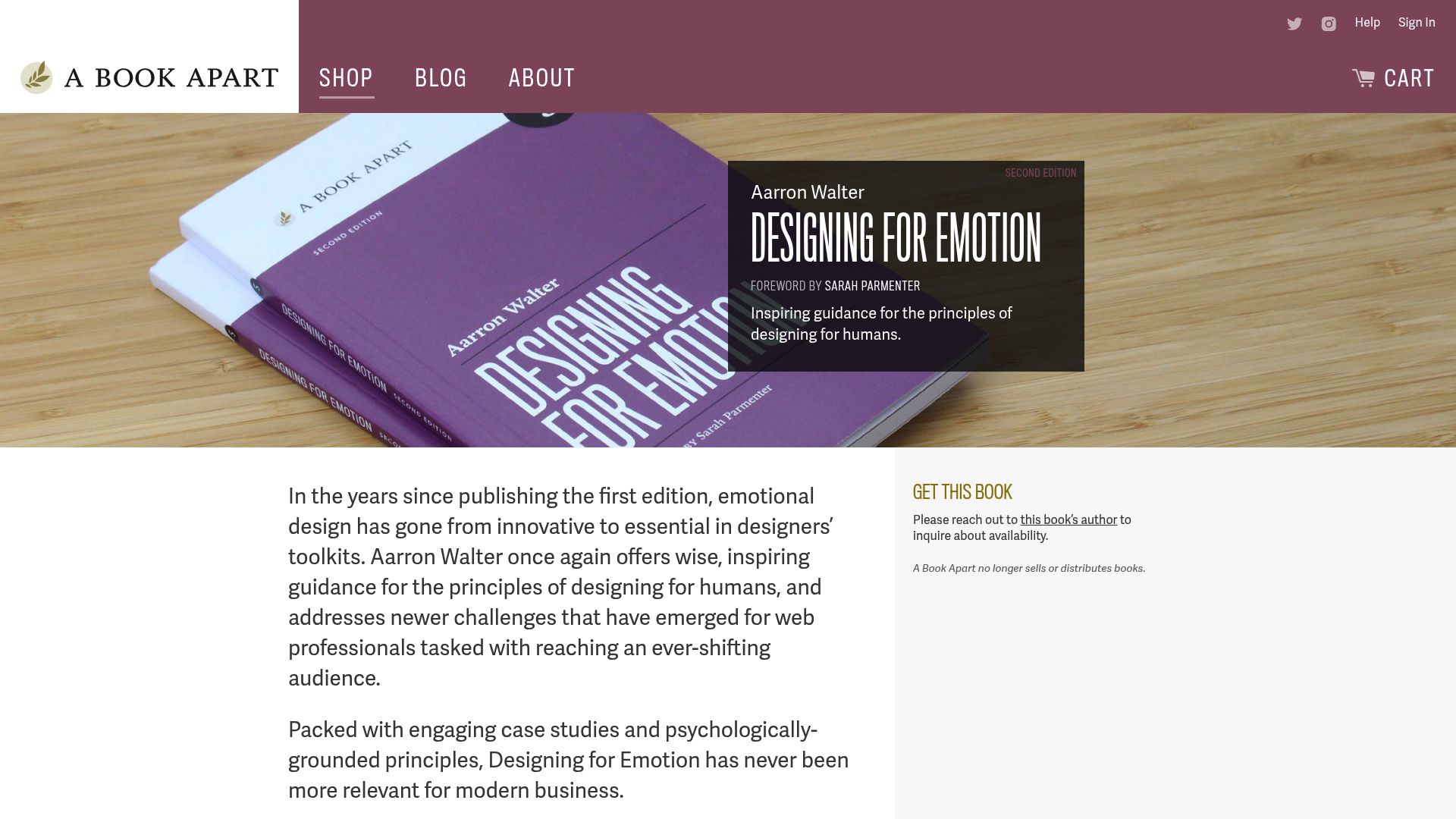
Key benefits:
- Human-centered approach
- Actionable techniques for evoking emotion
- Real-world examples
Target audience: UX/UI designers, product managers, marketers
Pros: Clear writing, practical focus
Cons: Less technical depth for advanced readers
Unique selling point: Pioneers the emotional layer of user experience, making it stand out among other ux books for its focus on feelings and connection.
2. The User Experience Team of One by Leah Buley
Leah Buley’s guide is perfect for those flying solo or working in small teams. This book offers practical tools and workflow tips, empowering readers to deliver outstanding UX even when resources are tight. Buley’s insights make it a standout among ux books for anyone looking to maximize impact with minimal support.
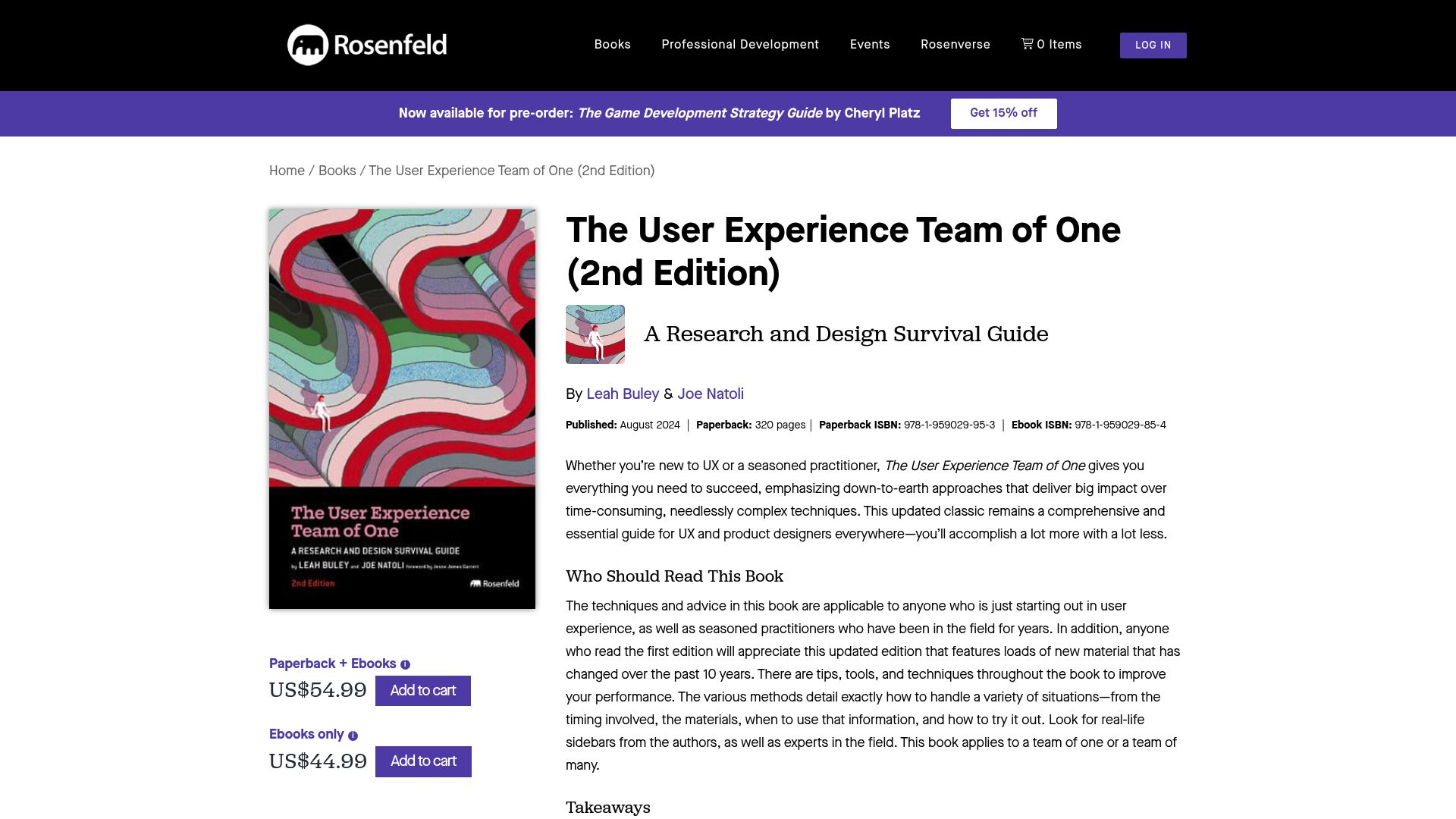
Pricing: Paperback and ebook available
Core features:
- Solo UX strategies
- Workflow optimization
- Adaptable tools
Key benefits: Empowers individuals, highly actionable
Target audience: Solo designers, startup founders, product leads
Pros: Adaptable, concise
Cons: Focused on solo work, less on large teams
Unique selling point: Among ux books, it’s the go-to guide for resource-constrained teams aiming for big results.
3. Don't Make Me Think, Revisited by Steve Krug
Steve Krug’s classic continues to top lists of essential ux books. "Don’t Make Me Think" is revered for its straightforward usability principles and practical advice on intuitive navigation. The revised edition includes updated web examples, keeping it relevant for today’s designers and developers.
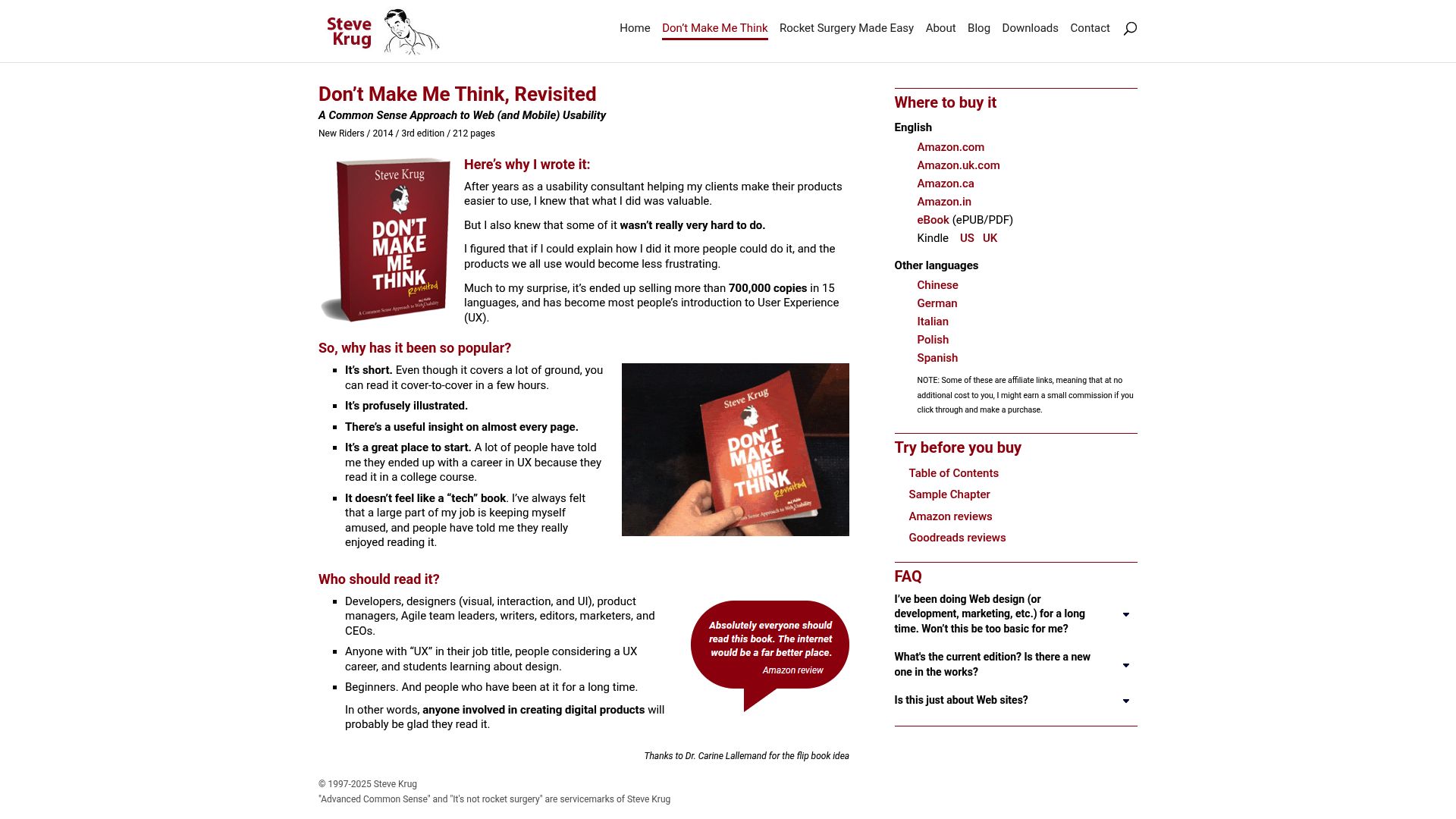
Core features:
- Usability principles
- Practical usability testing tips
- Intuitive navigation focus
Key benefits: Timeless advice, easy to read
Target audience: Web designers, developers, UX beginners
Pros: Accessible, concise
Cons: Web-centric, less depth on mobile/app design
Unique selling point: Remains a foundational resource for anyone building digital products, making it a staple among ux books.
4. Inclusive Design for a Digital World by Regine M. Gilbert
"Inclusive Design for a Digital World" by Regine M. Gilbert is a comprehensive resource for accessibility and inclusion. This book covers the latest standards and best practices for 2025, making it relevant for anyone serious about creating accessible digital experiences.
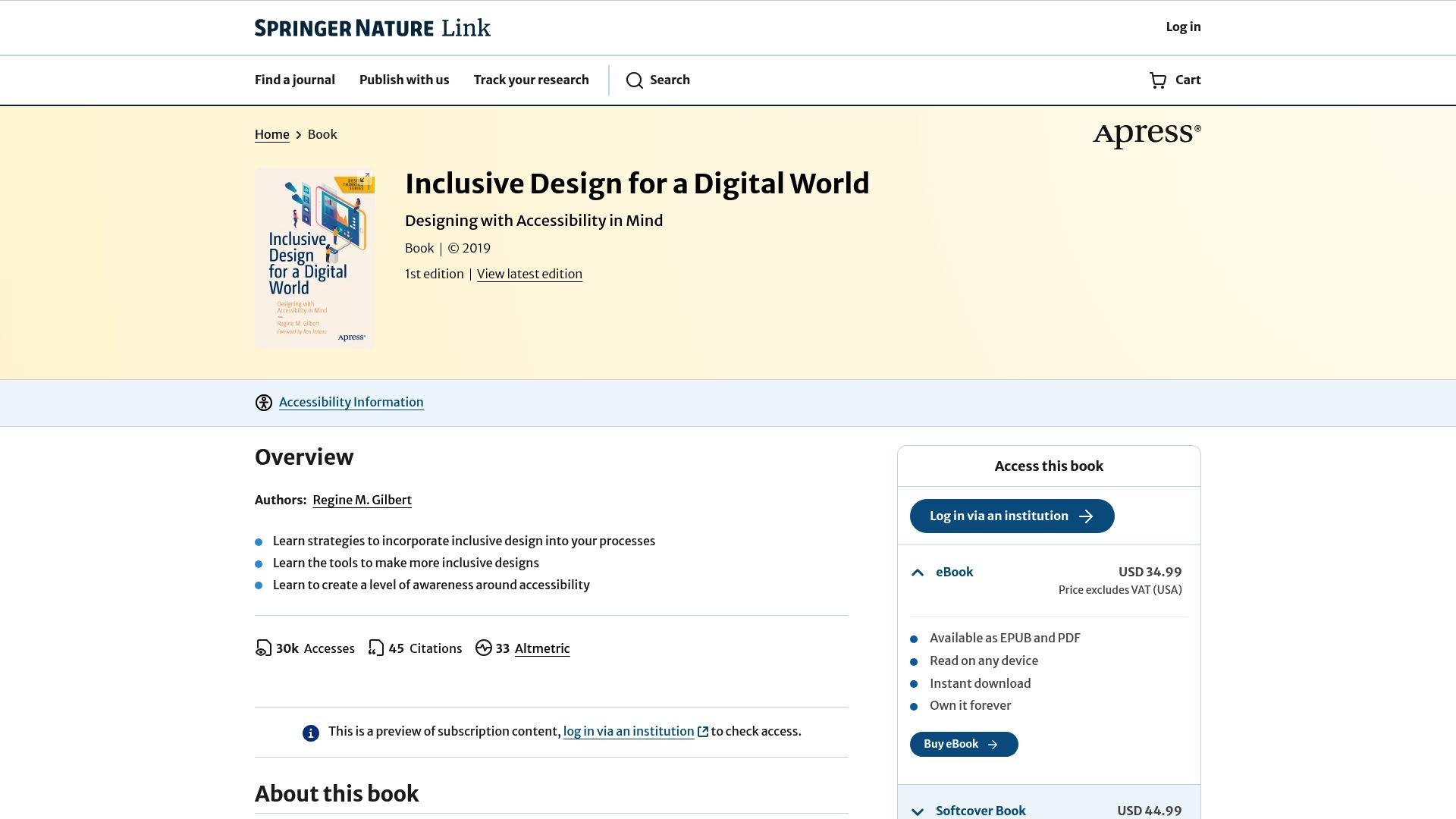
Pricing: Print and digital formats
Core features:
- Accessibility principles
- Inclusive design strategies
- Compliance guidelines
Key benefits: Real-world case studies, actionable checklists
Target audience: Designers, developers, accessibility advocates
Pros: Comprehensive, up-to-date
Cons: Some technical jargon
Unique selling point: Among ux books, it stands out for its depth on accessibility and its practical guidance for real-world projects.
5. Lean UX: Designing Great Products with Agile Teams by Jeff Gothelf & Josh Seiden
"Lean UX" is essential reading for those working in agile environments. This book focuses on collaborative workflows, rapid iteration, and continuous improvement—core themes for modern teams.
Pricing: Print, ebook, O’Reilly subscription
Core features:
- Agile UX integration
- Team collaboration
- Rapid prototyping
Key benefits: Emphasizes teamwork and adaptability
Target audience: Product teams, agile practitioners, UX leads
Pros: Practical, team-focused
Cons: Assumes some agile background
Unique selling point: Updated for 2025, "Lean UX" remains a leader among ux books for its actionable approach to agile product design.
6. UX Research: Practical Techniques for Designing Better Products by Brad Nunnally & David Farkas
This book bridges the gap between research theory and hands-on execution. It’s one of the few ux books that offers step-by-step guidance alongside templates and real-world scenarios, making it beginner-friendly yet practical for teams.
Core features:
- Research methodologies
- User interviews
- Data analysis techniques
Key benefits: Comprehensive, easy to follow
Target audience: UX researchers, designers, product managers
Pros: Detailed, accessible
Cons: Less advanced for seasoned researchers
Unique selling point: Among ux books, it’s a standout for making research approachable and directly applicable to product design.
7. The Elements of User Experience by Jesse James Garrett
Jesse James Garrett’s classic is known for its five-plane model, offering a holistic framework for UX. It’s a foundational text that helps readers understand the structure behind every successful digital product.
Core features:
- Five-plane UX model
- Strategic design thinking
- Visual frameworks
Key benefits: Structured, cross-disciplinary relevance
Target audience: Designers, strategists, product owners
Pros: Clear explanations, foundational
Cons: Less focus on new tech
Unique selling point: As one of the most referenced ux books, it remains essential for grasping the building blocks of user experience in 2025.
8. Sprint: How to Solve Big Problems and Test New Ideas in Just Five Days by Jake Knapp et al.
"Sprint" introduces a five-day framework for solving problems and testing ideas quickly. It’s a favorite among ux books for product teams and startups looking to innovate at speed. The 2025 edition includes updates for remote collaboration.
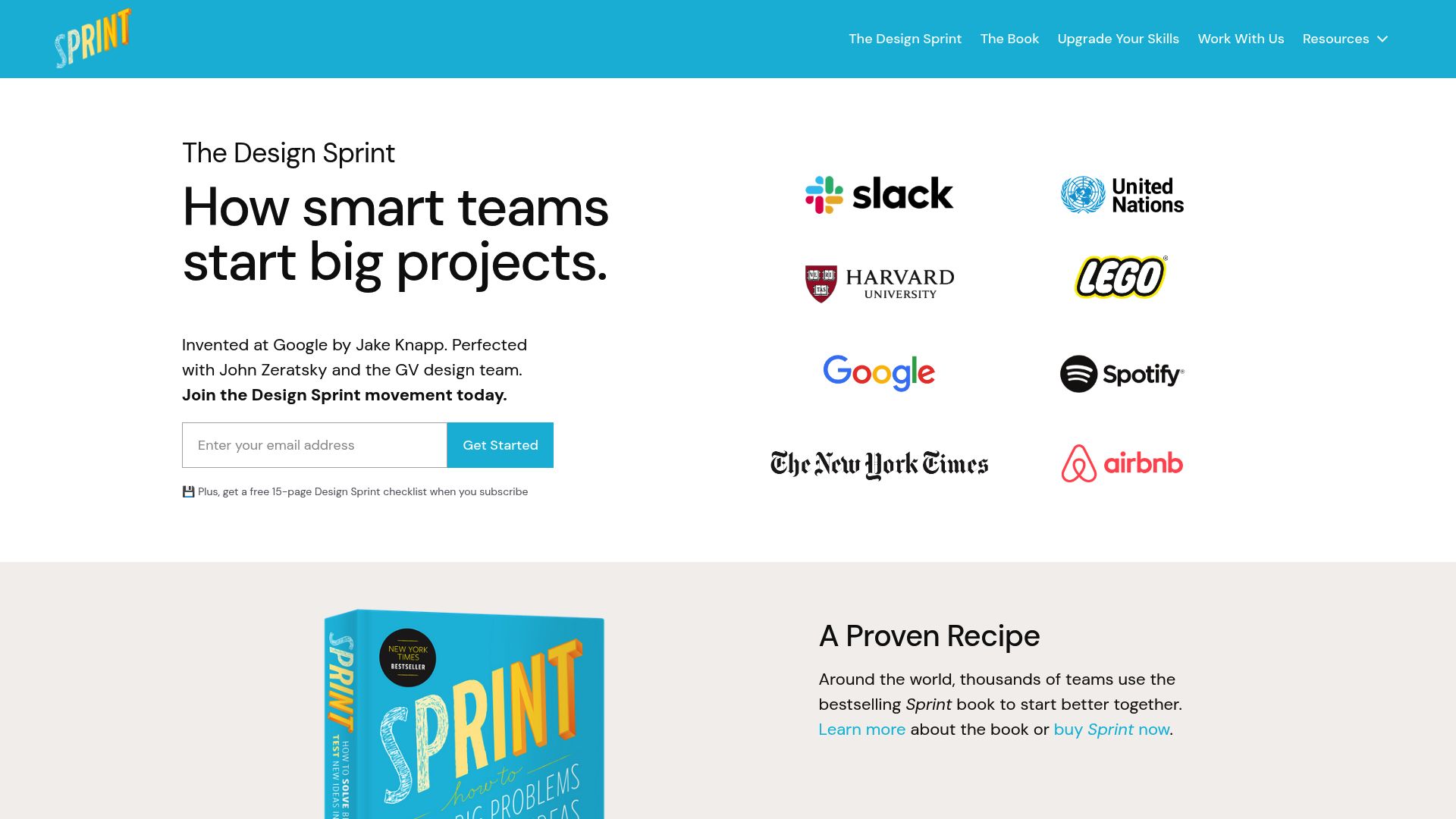
Core features:
- Five-day design sprint
- Rapid prototyping
- Team alignment
Key benefits: Quick validation, actionable steps
Target audience: Product teams, startups, innovation leaders
Pros: Actionable, time-efficient
Cons: May require organizational buy-in
Unique selling point: Among ux books, "Sprint" is unique for its time-boxed approach to innovation, making it perfect for fast-paced teams.
9. About Face: The Essentials of Interaction Design by Alan Cooper et al.
"About Face" is a comprehensive guide to interaction design. It covers personas, behavior-driven design, and the latest interaction paradigms, making it one of the most in-depth ux books available.
Pricing: Hardcover, paperback, ebook
Core features:
- Interaction design principles
- Personas
- Detailed frameworks
Key benefits: Theory-backed, comprehensive
Target audience: Interaction designers, UX strategists, educators
Pros: In-depth, widely cited
Cons: Lengthy, dense for beginners
Unique selling point: Stands out among ux books for its academic rigor and up-to-date insights on interaction design.
10. 100 Things Every Designer Needs to Know About People by Susan Weinschenk
Susan Weinschenk’s book bridges psychology and design, offering bite-sized lessons grounded in behavioral science. It’s a favorite among ux books for those who want to understand what truly drives user behavior.
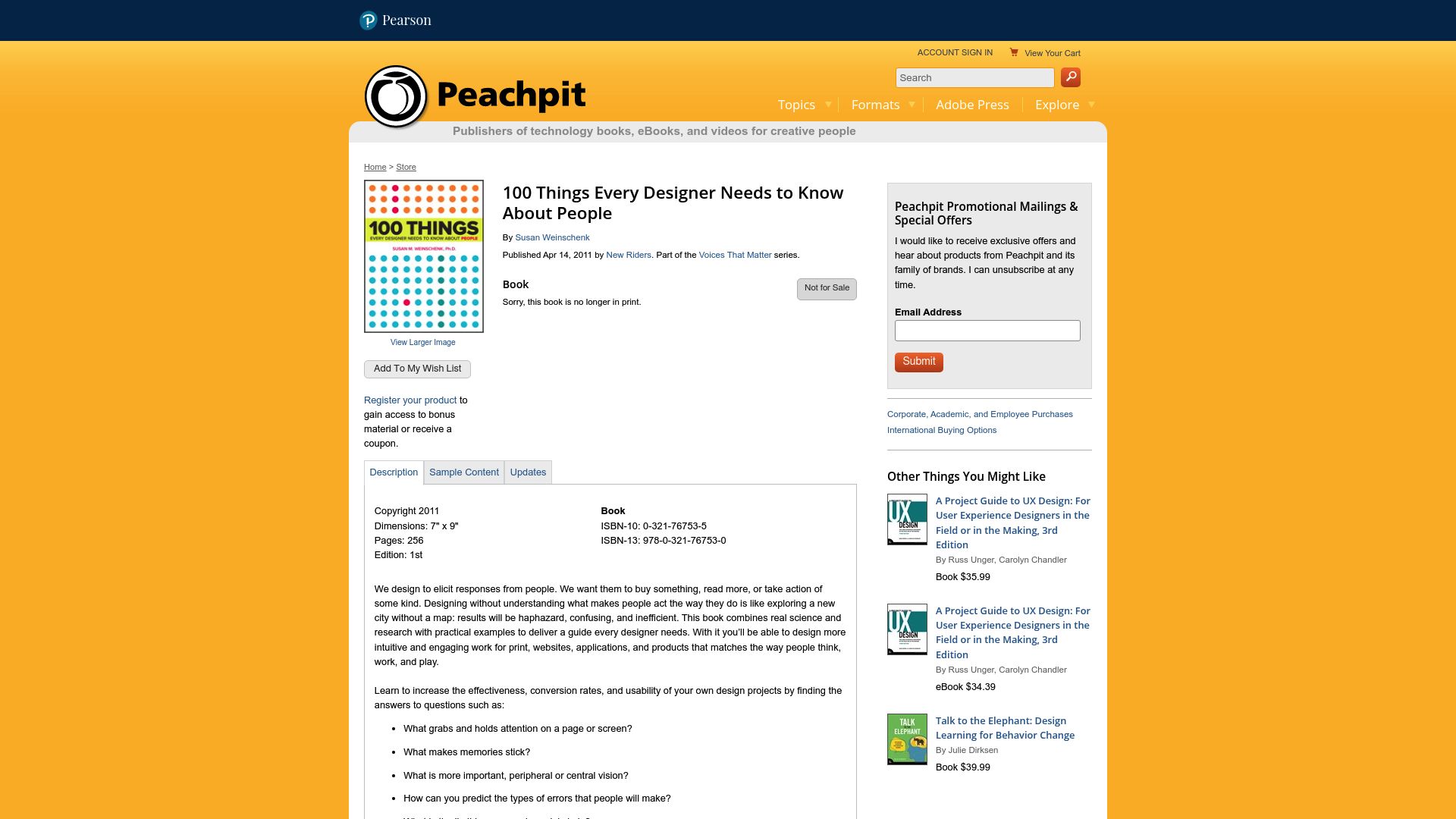
Core features:
- Cognitive principles
- Psychology-driven insights
- Practical tips
Key benefits: Engaging, easy to digest
Target audience: Designers, marketers, UX writers
Pros: Broad, practical
Cons: Less technical depth
Unique selling point: Updated for 2025, this book stands out among ux books for its focus on the science of what makes people tick.
Summary Table: Key Features of Top 10 UX Books
| Book Title | Core Focus | Target Audience | Unique Selling Point |
|---|---|---|---|
| Designing for Emotion | Emotional design | Designers, PMs | Emotional connections |
| The UX Team of One | Solo UX | Small teams | Resource-maximizing |
| Don't Make Me Think | Usability | Beginners, web devs | Timeless usability |
| Inclusive Design | Accessibility | All designers | Latest standards |
| Lean UX | Agile UX | Product teams | Agile collaboration |
| UX Research | Research | Researchers | Practical execution |
| Elements of UX | Frameworks | Strategists | Five-plane model |
| Sprint | Rapid innovation | Startups | Five-day process |
| About Face | Interaction design | Advanced UX | In-depth coverage |
| 100 Things | Psychology | All designers | Behavioral insights |
These ux books are more than just reading material—they’re tools for growth, innovation, and making a measurable impact on your work. Whether you’re seeking foundational knowledge or the latest industry trends, this list is your roadmap for 2025.
How to Get the Most Out of Your UX Reading List
Diving into a stack of ux books is just the beginning. To truly benefit, you need a plan that transforms reading into real-world growth. Let’s explore how you can actively engage with your ux books, apply what you learn, and build habits that stick.
Active Reading: Strategies for Deeper Learning
To get the most from your ux books, go beyond passive reading. Try these active strategies:
- Take detailed notes as you read, summarizing key concepts in your own words.
- Create mind maps to visualize relationships between ideas and frameworks.
- Discuss chapters with peers or in online forums to challenge and refine your understanding.
Studies show that active reading techniques like these can boost retention rates by up to 30% compared to reading alone. The more you interact with the material, the more likely you are to integrate new ideas into your workflow.
Applying Insights from UX Books to Real Projects
Transformation happens when you apply lessons from ux books directly to your design challenges. For example, a designer facing complex navigation issues might combine strategies from multiple books to craft a user-friendly solution.
One case study showed that teams who regularly reference ux books during sprints deliver more intuitive products and see measurable improvements in user retention. For deeper insights, research like The Influence of UX Design on User Retention and Conversion Rates in Mobile Apps demonstrates how book-driven UX improvements can move the needle on business metrics.
Engaging with the UX Community
Learning from ux books is even more powerful when you share the journey. Join a local or virtual UX book club to exchange perspectives and stay motivated. Participate in online communities where readers discuss the latest releases, share summaries, and recommend related podcasts or author talks.
Engagement with others exposes you to diverse viewpoints and helps you see how different professionals interpret and use the ideas from ux books in their own contexts.
Building a Sustainable UX Reading Habit
Consistency is key to making the most of your ux books. Set achievable reading goals—like one chapter per week or a new book each month. Track your progress in a journal or app, and celebrate milestones.
To avoid overwhelm, mix in book summaries, podcasts, or author interviews for lighter learning days. Remember, building a habit is about steady progress, not perfection.
If you’re inspired to level up your UX skills after exploring these essential reads, why not take the next step for your product? At Grauberg, we believe that understanding the whole user journey—just like these books emphasize—can make all the difference for startups aiming to boost conversion and reach product-market fit faster. If you’re curious about how your website and product experience stack up, let’s connect. You can Book a free Product-Website Audit and get actionable insights tailored to your business. It’s a great way to put your new UX knowledge into practice!
